The magnetic ballast industry stands at the threshold of a decade-long expansion trajectory that promises to reshape lighting control technology and electrical infrastructure systems. The market's journey from USD 1,000.9 million in 2025 to USD 1,481.6 million by 2035 represents substantial growth, demonstrating the accelerating adoption of reliable magnetic ballast systems across residential, commercial, and industrial lighting applications worldwide.
The first half of the decade (2025-2030) will witness the market climbing from USD 1,000.9 million to approximately USD 1,217.8 million, adding USD 216.9 million in value, which constitutes 45% of the total forecast growth period. This phase will be characterized by the rapid adoption of Power Below 300W magnetic ballast systems, driven by increasing residential lighting modernization and commercial infrastructure development programs worldwide. Advanced power regulation capabilities and reliable performance features will become standard expectations rather than premium options.
The latter half (2030-2035) will witness sustained growth from USD 1,217.8 million to USD 1,481.6 million, representing an addition of USD 263.8 million or 55% of the decade's expansion. This period will be defined by mass market penetration of higher power rating systems, integration with comprehensive lighting platforms, and seamless compatibility with existing electrical infrastructure. The market trajectory signals fundamental shifts in how commercial and industrial facilities approach lighting control and power management, with participants positioned to benefit from sustained demand across multiple application segments.
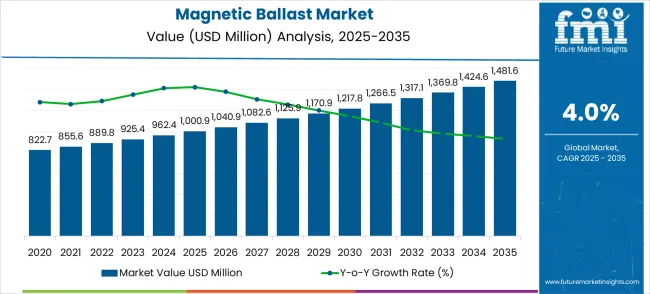
The Magnetic Ballast market demonstrates distinct growth phases with varying market characteristics and competitive dynamics. Between 2025 and 2030, the market progresses through its technology adoption phase, expanding from USD 1,000.9 million to USD 1,217.8 million with steady annual increments averaging 4.0% growth. This period showcases the transition from basic power regulation units to advanced systems with enhanced efficiency capabilities and integrated control features, becoming mainstream applications.
The 2025-2030 phase adds USD 216.9 million to market value, representing 45% of total decade expansion. Market maturation factors include standardization of electrical safety protocols, declining component costs for magnetic core assemblies, and increasing commercial awareness of reliable ballast technology benefits reaching 90-95% effectiveness in lighting control applications. Competitive landscape evolution during this period features established electrical manufacturers like Magnetek Inc. and Philips expanding their magnetic ballast portfolios while new entrants focus on compact designs and enhanced power efficiency.
From 2030 to 2035, market dynamics shift toward advanced integration and multi-application deployment, with growth accelerating from USD 1,217.8 million to USD 1,481.6 million, adding USD 263.8 million or 55% of total expansion. This phase transition logic centers on higher power rating systems, integration with smart lighting networks, and deployment across diverse commercial scenarios, becoming standard rather than specialized applications. The competitive environment matures with focus shifting from basic power regulation capability to comprehensive lighting control systems and integration with building automation platforms.
| Metric | Value |
|---|---|
| $ Market Value (2025) | USD 1,000.9 million |
| $ Market Forecast (2035) | USD 1,481.6 million |
| # Growth Rate | 4.0% CAGR |
| Leading Technology | Power Below 300W |
| Primary Application | Home Lamps Segment |
The market demonstrates strong fundamentals with Power Below 300W systems capturing a dominant share through advanced efficiency and reliable power regulation capabilities. Home Lamps applications drive primary demand, supported by increasing residential construction and lighting modernization programs. Geographic expansion remains concentrated in developed markets with established electrical infrastructure, while emerging economies show accelerating adoption rates driven by urbanization and rising residential construction activity.
Market expansion rests on three fundamental shifts driving adoption across residential, commercial, and industrial sectors. 1. Reliable power regulation demand creates compelling operational advantages through magnetic ballast systems that provide consistent lighting performance without electronic complexity, enabling facilities to maintain stable illumination while reducing maintenance requirements and system failure risks. 2. Residential construction programs accelerate as building developers worldwide seek proven lighting control technology that complements traditional electrical systems, enabling cost-effective lamp operation and reliable long-term performance that aligns with building codes and electrical safety standards. 3. Commercial infrastructure enhancement drives adoption from facility managers and electrical contractors requiring dependable lighting control solutions that minimize operational complexity while maintaining consistent performance during extended operation periods and varying load conditions.
However, growth faces headwinds from energy efficiency regulations that increasingly favor electronic ballast alternatives with lower power consumption profiles, potentially limiting the deployment of magnetic ballasts in energy-conscious commercial applications. Technical limitations also persist regarding power efficiency and heat generation characteristics that may reduce system attractiveness in applications requiring maximum energy conservation and minimal thermal output.
Primary Classification: The market segments by power rating into Power Below 300W, Power 300-600W, and Power Above 600W categories, representing the evolution from residential lighting systems to commercial and industrial applications requiring higher power handling capabilities.
Secondary Breakdown: Application segmentation divides the market into Home Lamps, Commercial Lamps, and Industrial Lamps sectors, reflecting distinct requirements for residential lighting, commercial facility illumination, and industrial workspace applications.
Regional Classification: Geographic distribution covers Asia Pacific, North America, Europe, Latin America, and the Middle East & Africa, with developed markets leading adoption while emerging economies show accelerating growth patterns driven by construction activity and infrastructure development programs.
The segmentation structure reveals technology progression from low-power residential systems toward higher-capacity commercial and industrial platforms with enhanced power handling and extended operational capabilities, while application diversity spans from home lighting applications to specialized industrial lighting systems requiring robust power regulation solutions.
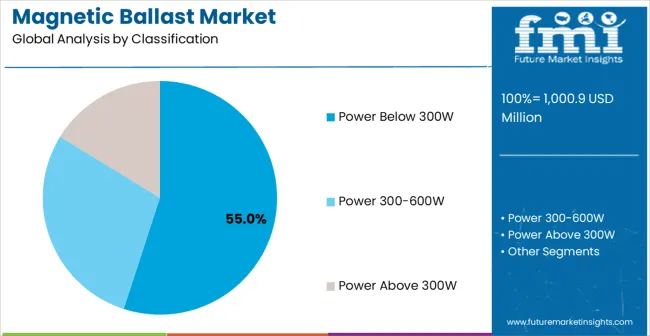
Market Position: Power Below 300W systems command the leading position in the Magnetic Ballast market through advanced efficiency features, including reliable power regulation, compact design, and cost-effective operation that enable residential and small commercial applications to deploy proven magnetic ballast technology across diverse lighting environments.
Value Drivers: The segment benefits from residential preference for proven ballast technology that provides consistent lamp performance without requiring complex electronic components or specialized maintenance procedures. Reliable design features enable deployment in home lighting applications, small office installations, and retail environments where dependability and cost-effectiveness represent critical operational requirements.
Competitive Advantages: Power Below 300W systems differentiate through proven reliability, simple installation procedures, and compatibility with standard lamp types that enhance user accessibility while maintaining cost-effective operational profiles suitable for residential and small commercial applications.
Key market characteristics:
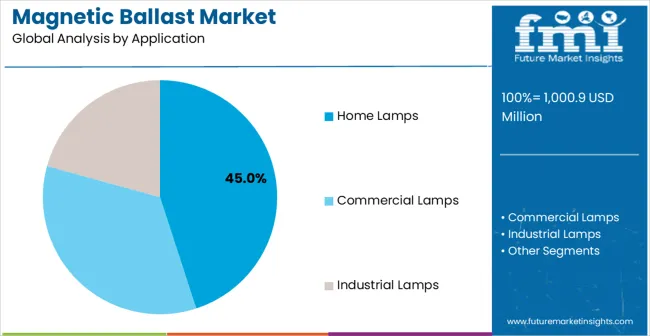
Market Context: Home Lamps applications dominate the Magnetic Ballast market due to widespread residential construction activity and increasing focus on reliable lighting systems that provide consistent performance while maintaining cost-effective operation for homeowners and residential developers.
Appeal Factors: Residential customers prioritize system reliability, long-term durability, and compatibility with standard electrical infrastructure that enables straightforward installation and maintenance without requiring specialized technical expertise. The segment benefits from substantial residential construction activity and lighting upgrade programs that emphasize proven magnetic ballast technology for dependable home lighting applications.
Growth Drivers: Residential construction programs incorporate magnetic ballasts as standard equipment for home lighting systems. At the same time, renovation projects increasingly demand reliable lighting control technology that provides consistent performance with minimal maintenance requirements and long operational life.
Market Challenges: Energy efficiency regulations and LED lighting adoption may limit magnetic ballast deployment in residential applications seeking maximum energy conservation and reduced operational costs.
Application dynamics include:
Growth Accelerators: Residential construction drives primary adoption as magnetic ballast systems provide reliable lighting control capabilities that enable consistent lamp performance without electronic complexity, supporting home lighting applications and commercial installations that require proven power regulation technology. Infrastructure development demand accelerates market expansion as electrical contractors seek dependable ballast solutions that provide long-term reliability while maintaining cost-effective operation during residential and commercial lighting projects. Building construction increases worldwide, creating sustained demand for reliable lighting control technology that complements traditional electrical systems and provides operational stability in diverse lighting environments.
Growth Inhibitors: Energy efficiency regulations increasingly favor electronic ballast alternatives with lower power consumption and reduced heat generation, which may limit magnetic ballast adoption in energy-conscious applications seeking maximum efficiency performance. LED lighting technology advancement creates competitive pressure through solid-state lighting systems that eliminate ballast requirements, potentially reducing magnetic ballast demand in retrofit and new construction applications. Market fragmentation across multiple electrical specifications and building codes creates compatibility concerns between different ballast manufacturers and existing lighting infrastructure.
Market Evolution Patterns: Adoption concentrates in residential and traditional commercial sectors where proven technology justifies operational costs, with geographic concentration in developed markets transitioning toward mainstream adoption in emerging economies driven by construction activity and electrical infrastructure development. Technology development focuses on improved magnetic core efficiency, enhanced power factor correction, and compatibility with emerging lamp technologies that optimize performance and regulatory compliance. The market could face disruption if LED lighting adoption or energy efficiency regulations significantly limit magnetic ballast deployment in residential or commercial applications.
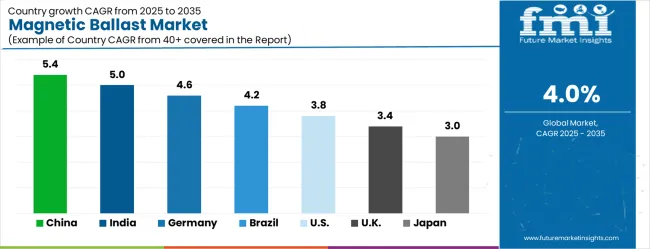
| Country | CAGR (2025-2035) |
|---|---|
| China | 5.4% |
| India | 5.0% |
| Germany | 4.6% |
| Brazil | 4.2% |
| USA | 3.8% |
| UK | 3.4% |
| Japan | 3.0% |
The Magnetic Ballast market demonstrates varied regional dynamics with Growth Leaders including China (5.4% CAGR) and India (5.0% CAGR) driving expansion through construction activity and electrical infrastructure development. Steady Performers encompass Germany (4.6% CAGR), Brazil (4.2% CAGR), and the USA (3.8% CAGR), benefiting from established electrical industries and residential construction technology adoption. Emerging Markets feature the UK (3.4% CAGR) and Japan (3.0% CAGR), where specialized lighting applications and electrical system integration support consistent growth patterns.
Regional synthesis reveals Asia-Pacific markets leading growth through construction activity and electrical infrastructure development, while European countries maintain steady expansion supported by residential construction advancement and electrical system integration requirements. North American markets show moderate growth driven by residential construction applications and electrical infrastructure modernization trends.
China establishes market leadership through aggressive construction programs and comprehensive electrical infrastructure development, integrating magnetic ballast systems as standard components in residential lighting and commercial facility applications. The country's 5.4% CAGR through 2035 reflects government initiatives promoting electrical infrastructure development and domestic manufacturing capabilities that mandate reliable lighting control systems in residential and commercial installations. Growth concentrates in major construction centers, including Beijing, Shanghai, and Guangzhou, where residential development showcases integrated magnetic ballast systems that appeal to builders seeking reliable lighting control capabilities and cost-effective electrical solutions.
Chinese manufacturers are developing cost-effective magnetic ballast solutions that combine domestic production advantages with proven reliability features, including standard power regulation and extended operational life capabilities. Distribution channels through electrical supply networks and construction equipment suppliers expand market access, while government funding for infrastructure development supports adoption across diverse residential and commercial segments.
Strategic Market Indicators:
In Mumbai, Delhi, and Bangalore, residential and commercial construction projects are implementing magnetic ballast systems as standard equipment for lighting applications, driven by increasing construction activity and infrastructure development programs that emphasize the use of reliable electrical components for building projects. The market is projected to demonstrate a 5.0% CAGR through 2035, supported by government construction initiatives and residential development programs that promote proven lighting control technology for residential and commercial applications. Indian construction companies are adopting magnetic ballast systems that provide dependable lighting control capabilities and cost-effective operation, particularly appealing in residential developments where reliable performance represents critical operational requirements.
Market expansion benefits from growing electrical manufacturing capabilities and construction industry development that enables domestic production of reliable ballast systems for residential and commercial applications. Technology adoption follows patterns established in electrical infrastructure, where reliability and cost-effectiveness drive procurement decisions and construction deployment.
Market Intelligence Brief:
Germany's advanced electrical technology market demonstrates sophisticated magnetic ballast deployment with documented operational effectiveness in residential construction and commercial facility applications through integration with existing electrical systems and building infrastructure. The country leverages engineering expertise in electrical technology and construction systems integration to maintain a 4.6% CAGR through 2035. Construction centers, including Munich, Hamburg, and Frankfurt, showcase premium installations where magnetic ballasts integrate with comprehensive electrical platforms and building systems to optimize lighting control and power regulation effectiveness.
German electrical manufacturers prioritize system reliability and European standards compliance in magnetic ballast development, creating demand for premium systems with advanced features, including enhanced power factor correction and integration with building electrical systems. The market benefits from established electrical industry infrastructure and willingness to invest in proven lighting control technology that provides long-term operational benefits and compliance with European electrical safety requirements.
Market Intelligence Brief:
Brazil's market expansion benefits from diverse construction demand, including residential development in São Paulo and Rio de Janeiro, commercial construction equipment upgrades, and government infrastructure programs that increasingly incorporate reliable electrical components for lighting control applications. The country maintains a 4.2% CAGR through 2035, driven by rising construction activity and increasing awareness of magnetic ballast technology benefits, including dependable power regulation and long-term operational reliability capabilities.
Market dynamics focus on cost-effective magnetic ballast solutions that balance proven performance features with affordability considerations important to Brazilian construction companies. Growing urbanization creates sustained demand for reliable lighting control systems in new construction infrastructure and residential development projects.
Strategic Market Considerations:
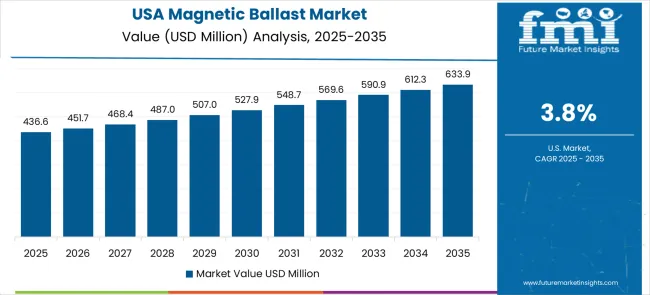
The USA market emphasizes advanced magnetic ballast features, including enhanced power regulation and integration with comprehensive electrical platforms that manage residential lighting, commercial facility illumination, and industrial applications through unified electrical systems. The country is projected to show a 3.8% CAGR through 2035, driven by construction modernization under building equipment upgrades and residential development demand for reliable lighting control systems. American construction companies prioritize operational effectiveness with magnetic ballasts delivering consistent power regulation through proven electrical technology and environmental adaptation capabilities.
Technology deployment channels include major electrical distributors, specialized construction equipment suppliers, and residential development programs that support professional installation for complex building applications. Building system integration capabilities with established electrical infrastructure expands market appeal across diverse construction requirements seeking reliability and performance benefits.
Performance Metrics:
Japan demonstrates steady market development with a 3.0% CAGR through 2035, distinguished by the construction industry's preference for high-quality magnetic ballasts that integrate seamlessly with existing electrical systems and provide reliable long-term operation in specialized building applications. The market prioritizes advanced features, including precision power regulation, operational durability, and integration with comprehensive electrical platforms that reflect Japanese construction expectations for technological sophistication and operational excellence.
In London, Birmingham, and other construction centers, British building companies and electrical contractors are implementing magnetic ballast systems to enhance lighting control capabilities and support residential construction projects that align with British electrical standards and reliable power regulation protocols. The UK market demonstrates sustained growth with a 3.4% CAGR through 2035, driven by construction modernization programs and electrical equipment upgrades that emphasize proven electrical components for residential and commercial building applications. British construction companies are prioritizing magnetic ballast systems that provide reliable power regulation capabilities while maintaining compliance with electrical safety requirements and minimizing operational complexity, particularly important in residential developments and commercial construction projects.
Market expansion benefits from construction industry procurement programs that mandate reliable electrical components in building equipment specifications, creating sustained demand across the UK's residential and commercial construction sectors, where operational reliability and proven performance represent critical requirements. The regulatory framework supports magnetic ballast adoption through electrical equipment standards and building code compliance requirements that promote proven electrical systems aligned with construction industry capabilities.
Strategic Market Indicators:
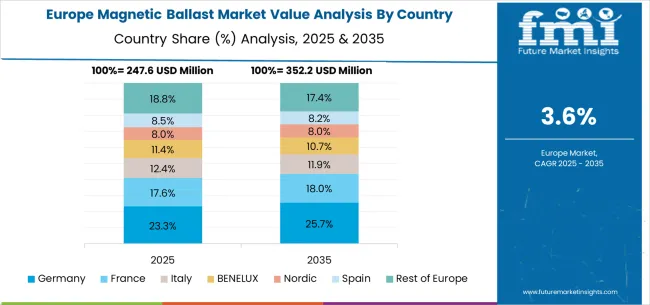
The European Magnetic Ballast market is projected to grow from USD 31.3 million in 2025 to USD 50.4 million by 2035, registering a CAGR of 4.9% over the forecast period. Germany is expected to maintain its leadership position with a 28.5% market share in 2025, declining slightly to 27.9% by 2035, supported by its advanced electrical technology infrastructure and major construction centers, including Munich and Hamburg.
France follows with a 21.4% share in 2025, projected to reach 21.8% by 2035, driven by comprehensive construction modernization programs and electrical technology development initiatives. The United Kingdom holds an 18.7% share in 2025, expected to maintain 18.5% by 2035 through specialized electrical applications and European standards compliance requirements. Italy commands a 13.9% share, while Spain accounts for 9.7% in 2025. The Rest of Europe region is anticipated to gain momentum, expanding its collective share from 7.8% to 8.3% by 2035, attributed to increasing magnetic ballast adoption in Nordic countries and emerging Eastern European construction companies implementing electrical infrastructure modernization programs.
Power Below 300W Dominates Magnetic Ballast System Demand in Japan
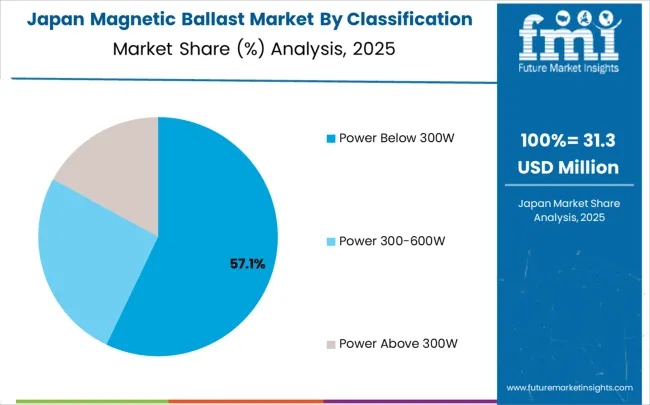
In Japan, the Magnetic Ballast market prioritizes Power Below 300W systems, which capture the dominant share of residential and commercial installations through advanced features, including reliable power regulation and seamless integration with existing electrical infrastructure. Japanese construction companies emphasize durability, precision, and long-term operational excellence, creating demand for low-power systems that provide consistent lighting control capabilities and adaptive power management based on operational requirements and electrical load scenarios. Higher power rating systems maintain a secondary market position primarily in specialized industrial applications and commercial facility installations where enhanced power handling functionality meets operational requirements without residential deployment features.
Market Characteristics:
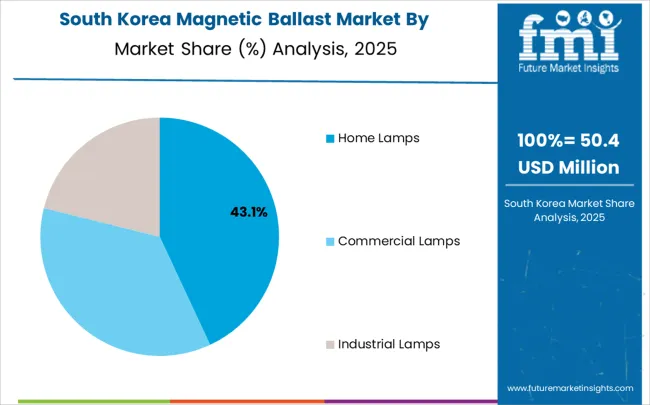
In South Korea, the market structure favors international electrical companies, including Philips, Signify Holding, and Magnetek Inc., which maintain dominant positions through comprehensive product portfolios and established construction industry networks supporting both residential developments and commercial installations. These providers offer integrated solutions combining reliable magnetic ballast systems with professional installation services and ongoing technical support that appeal to Korean construction companies seeking dependable electrical control systems. Local electrical contractors and system integrators capture a moderate market share by providing localized service capabilities and competitive pricing for standard construction installations, while domestic manufacturers focus on specialized applications and cost-effective solutions tailored for Korean electrical characteristics.
Channel Insights:
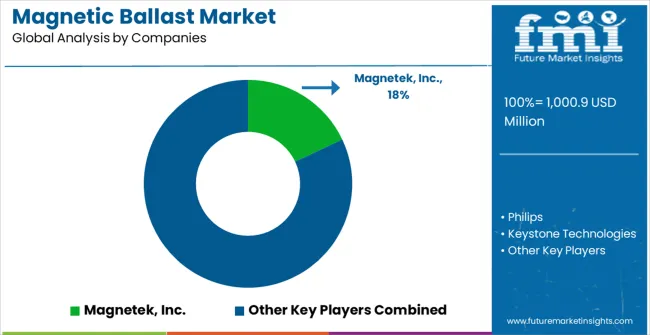
The Magnetic Ballast market operates with moderate concentration, featuring approximately 15-18 meaningful participants, where leading companies control roughly 50-55% of the global market share through established electrical industry relationships and comprehensive technology portfolios. Competition emphasizes reliable power regulation, system durability, and electrical system integration rather than price-based rivalry.
Market Leaders encompass Magnetek Inc., Philips, and Signify Holding, which maintain competitive advantages through extensive electrical technology expertise, global distribution networks, and comprehensive system integration capabilities that create customer switching costs and support premium pricing. These companies leverage decades of electrical industry experience and ongoing technology investments to develop advanced magnetic ballast systems with proven reliability and electrical safety features.
Technology Challengers include Keystone Technologies, Robertson, and Inter-Global Inc., which compete through specialized electrical component focus and innovative power regulation interfaces that appeal to construction customers seeking advanced reliability capabilities and operational flexibility. These companies differentiate through rapid technology development cycles and specialized building application focus.
Regional Specialists feature companies like ERC Highlight, Tridonic, and Osram, which focus on specific geographic markets and specialized applications, including commercial lighting systems and integrated electrical solutions. Market dynamics favor participants that combine reliable hardware with proven electrical technology, including consistent power regulation and long-term operational durability capabilities. Competitive pressure intensifies as traditional electrical manufacturers expand into magnetic ballast systems. At the same time, specialized component companies challenge established players through innovative electrical solutions and cost-effective platforms targeting specialized construction segments.
Magnetic ballasts represent a traditional yet resilient technology segment within the lighting control ecosystem, with market growth from USD 1,000.9 million in 2025 to USD 1,481.6 million by 2035, reflecting sustained demand for reliable, cost-effective power regulation solutions across residential and commercial lighting applications. The technology provides proven operational advantages through consistent lamp performance without electronic complexity, appealing to builders, electrical contractors, and facility managers prioritizing long-term reliability over advanced features. Power Below 300W systems dominate market demand due to widespread residential construction activity, while Home Lamps applications represent the largest segment, driven by new construction and renovation projects. However, the market faces significant headwinds from energy efficiency regulations favoring electronic alternatives and LED technology adoption that eliminates ballast requirements. Successful ecosystem development requires coordinated stakeholder action addressing regulatory compliance challenges, competitive pressure from solid-state lighting, and the need for improved power efficiency while capitalizing on construction growth and proven reliability advantages.
How Government Bodies and Regulatory Agencies Could Support Market Sustainability?
Balanced Energy Efficiency Standards: Develop nuanced building codes that recognize applications where magnetic ballasts provide optimal cost-effectiveness and reliability, particularly in residential construction and retrofit situations where electronic alternatives may not justify premium costs. Create tiered efficiency standards that account for total lifecycle costs, including maintenance, replacement frequency, and operational reliability, rather than focusing solely on energy consumption metrics.
Construction Industry Integration Programs: Include magnetic ballast specifications in government housing programs and public construction projects where cost-effectiveness and proven reliability outweigh marginal energy efficiency differences. Establish procurement guidelines that evaluate total ownership costs over 15-20 year operational periods, recognizing magnetic ballasts' extended service life and minimal maintenance requirements.
Technical Standards and Safety Protocols: Maintain updated safety standards and certification requirements for magnetic ballast systems that ensure proper electromagnetic interference control and electrical safety compliance. Develop standardized testing protocols that validate power factor correction capabilities and thermal management performance across different power rating categories.
Regional Manufacturing Support: Provide incentives for domestic magnetic ballast production capabilities that reduce import dependency and support local electrical manufacturing ecosystems. Create training programs for electrical trades focusing on proper magnetic ballast installation, maintenance, and troubleshooting techniques that ensure optimal system performance and safety compliance.
Building Code Integration: Establish provisions in residential and commercial building codes that recognize magnetic ballasts as approved technology for specific applications where reliability and cost-effectiveness represent primary selection criteria. Create regulatory pathways that streamline approval processes for magnetic ballast installations in renovation and retrofit projects.
How Electrical Industry Bodies Could Strengthen Market Position?
Technology Advancement and Standards: Develop improved magnetic core designs and power factor correction techniques that enhance efficiency while maintaining the reliability advantages that differentiate magnetic ballasts from electronic alternatives. Establish performance standards that highlight magnetic ballasts' operational benefits, including extended service life, thermal stability, and electromagnetic interference characteristics.
Professional Training and Certification: Create comprehensive educational programs for electrical contractors, maintenance technicians, and building operators covering optimal magnetic ballast application, installation best practices, and troubleshooting procedures. Develop certification programs that validate competency in traditional electrical technologies and their appropriate use in modern lighting installations.
Market Positioning and Communication: Lead messaging that emphasizes magnetic ballasts' total cost of ownership advantages, including 15-20 year service life, minimal maintenance requirements, and proven reliability in diverse environmental conditions. Create comparative analysis frameworks that demonstrate situations where magnetic ballasts provide superior value compared to electronic alternatives.
Supply Chain Coordination: Work with component suppliers to ensure adequate availability of specialized magnetic cores, copper windings, and enclosure materials required for magnetic ballast production. Develop quality standards that provide consistent performance across different manufacturers and regional production facilities.
How Manufacturers Could Navigate Technology Evolution and Market Challenges?
Efficiency Optimization and Innovation: Invest in advanced magnetic core materials and winding techniques that improve power factor performance and reduce electromagnetic interference while maintaining cost advantages. Develop hybrid designs that combine magnetic technology reliability with improved energy efficiency to address regulatory requirements without sacrificing proven operational benefits.
Market Segmentation and Application Focus: Identify and target specific applications where magnetic ballasts provide optimal value propositions, including residential construction, retrofit projects, and commercial installations, prioritizing long-term reliability over maximum efficiency. Develop specialized product lines tailored for emerging markets where cost-effectiveness and proven technology represent primary selection criteria.
Manufacturing Excellence and Cost Management: Implement lean production techniques and automated manufacturing processes that maintain cost competitiveness while ensuring consistent quality and performance standards. Establish regional production capabilities that reduce logistics costs and enable responsive customer service in key growth markets.
Integration and Compatibility Solutions: Design magnetic ballast systems with enhanced compatibility across different lamp types and electrical configurations, including improved starting characteristics and reduced audible noise. Create modular designs that facilitate installation and maintenance while supporting integration with building automation systems where appropriate.
How Electrical Contractors and Installation Partners Could Maximize Market Opportunities?
Technical Expertise and Service Excellence: Develop specialized knowledge of magnetic ballast applications, installation requirements, and troubleshooting techniques that enable contractors to provide expert guidance to customers evaluating lighting control options. Create service capabilities that emphasize long-term reliability and total cost advantages of magnetic ballast systems.
Market Education and Customer Advisory: Educate building owners and facility managers about situations where magnetic ballasts provide optimal solutions, including applications prioritizing reliability, cost-effectiveness, and minimal maintenance requirements. Develop comparison frameworks that demonstrate magnetic ballasts' advantages in specific use cases despite lower energy efficiency ratings.
Installation Optimization and Quality Assurance: Implement best practices for magnetic ballast installation that maximize performance, minimize electromagnetic interference, and ensure compliance with electrical safety standards. Create quality control procedures that validate proper installation and commissioning of magnetic ballast systems across different building types and electrical configurations.
Lifecycle Service and Maintenance: Establish preventive maintenance programs that leverage magnetic ballasts' extended service life and minimal maintenance requirements to provide cost-effective lighting system management. Develop retrofit expertise that enables cost-effective upgrades from older magnetic ballast systems to newer, more efficient designs.
How Construction Industry Stakeholders Could Leverage Technology Advantages?
Cost-Effective Building Strategies: Integrate magnetic ballast systems into construction budgets and specifications where proven reliability and low maintenance requirements align with long-term building operation objectives. Develop lifecycle cost analysis methodologies that account for magnetic ballasts' extended service life and minimal replacement requirements over building operational periods.
Residential Construction Integration: Incorporate magnetic ballast systems into residential construction standards where cost-effectiveness and proven reliability outweigh marginal energy efficiency differences. Create construction specifications that recognize magnetic ballasts as appropriate technology for residential lighting applications, prioritizing durability and operational simplicity.
Retrofit and Renovation Applications: Leverage magnetic ballasts' compatibility with existing electrical infrastructure for cost-effective lighting system upgrades in renovation projects where full electrical system replacement may not be economically justified. Develop retrofit strategies that maximize existing electrical infrastructure utilization while improving lighting control performance.
Regional Market Development: Focus on magnetic ballast adoption in markets where construction cost pressures and infrastructure limitations favor proven, cost-effective technology over premium efficiency solutions. Create regional supply chains and installation capabilities that support magnetic ballast deployment in emerging construction markets.
How Investors and Financial Enablers Could Support Market Evolution?
Strategic Technology Investment: Finance research and development programs focused on magnetic ballast efficiency improvements and advanced materials that enhance performance while maintaining cost advantages. Support technology development that addresses energy efficiency concerns without sacrificing the reliability and simplicity that define magnetic ballast value propositions.
Regional Market Expansion: Provide capital for magnetic ballast manufacturers expanding into high-growth construction markets, including Asia-Pacific regions, where cost-effectiveness and proven technology represent primary selection criteria. Finance regional manufacturing capabilities that enable competitive pricing and responsive customer service in emerging markets.
Niche Market Development: Support companies developing specialized magnetic ballast applications for specific industries or building types where unique requirements favor magnetic technology over electronic alternatives. Finance market development initiatives that identify and cultivate applications where magnetic ballasts provide optimal solutions.
Supply Chain Investment: Finance supply chain improvements and component sourcing optimization that maintain cost competitiveness while ensuring quality standards and delivery reliability. Support vertical integration strategies that provide manufacturers greater control over component costs and availability in competitive market environments.
Technology Transition Support: Provide financing for manufacturers developing hybrid or transitional technologies that combine magnetic ballast reliability with improved energy efficiency to address evolving regulatory requirements. Support market positioning strategies that emphasize total cost of ownership advantages in specific applications where magnetic ballasts remain competitive despite efficiency limitations.
| Item | Value |
|---|---|
| Quantitative Units | USD 1,000.9 million |
| Power Rating | Power Below 300W, Power 300-600W, Power Above 600W |
| Application | Home Lamps, Commercial Lamps, Industrial Lamps |
| Regions Covered | Asia Pacific, North America, Europe, Latin America, Middle East & Africa |
| Countries Covered | China, India, Germany, Brazil, the USA, the UK, Japan, and 25+ additional countries |
| Key Companies Profiled | Magnetek Inc., Philips, Keystone Technologies, Signify Holding, Robertson, Inter-Global Inc., ERC Highlight, Tridonic |
| Additional Attributes | Dollar sales by power rating and application categories, regional adoption trends across Asia Pacific, North America, and Europe, competitive landscape with electrical manufacturers and technology providers, construction preferences for reliable power regulation and system durability, integration with electrical systems and building infrastructure, innovations in magnetic core technology and power efficiency, and development of higher power rating solutions with enhanced operational capabilities. |
The global magnetic ballast market is estimated to be valued at USD 1,000.9 million in 2025.
The market size for the magnetic ballast market is projected to reach USD 1,481.6 million by 2035.
The magnetic ballast market is expected to grow at a 4.0% CAGR between 2025 and 2035.
The key product types in magnetic ballast market are power below 300w, power 300-600w and power above 300w.
In terms of application, home lamps segment to command 45.0% share in the magnetic ballast market in 2025.






Our Research Products

The "Full Research Suite" delivers actionable market intel, deep dives on markets or technologies, so clients act faster, cut risk, and unlock growth.

The Leaderboard benchmarks and ranks top vendors, classifying them as Established Leaders, Leading Challengers, or Disruptors & Challengers.

Locates where complements amplify value and substitutes erode it, forecasting net impact by horizon

We deliver granular, decision-grade intel: market sizing, 5-year forecasts, pricing, adoption, usage, revenue, and operational KPIs—plus competitor tracking, regulation, and value chains—across 60 countries broadly.

Spot the shifts before they hit your P&L. We track inflection points, adoption curves, pricing moves, and ecosystem plays to show where demand is heading, why it is changing, and what to do next across high-growth markets and disruptive tech

Real-time reads of user behavior. We track shifting priorities, perceptions of today’s and next-gen services, and provider experience, then pace how fast tech moves from trial to adoption, blending buyer, consumer, and channel inputs with social signals (#WhySwitch, #UX).

Partner with our analyst team to build a custom report designed around your business priorities. From analysing market trends to assessing competitors or crafting bespoke datasets, we tailor insights to your needs.
Supplier Intelligence
Discovery & Profiling
Capacity & Footprint
Performance & Risk
Compliance & Governance
Commercial Readiness
Who Supplies Whom
Scorecards & Shortlists
Playbooks & Docs
Category Intelligence
Definition & Scope
Demand & Use Cases
Cost Drivers
Market Structure
Supply Chain Map
Trade & Policy
Operating Norms
Deliverables
Buyer Intelligence
Account Basics
Spend & Scope
Procurement Model
Vendor Requirements
Terms & Policies
Entry Strategy
Pain Points & Triggers
Outputs
Pricing Analysis
Benchmarks
Trends
Should-Cost
Indexation
Landed Cost
Commercial Terms
Deliverables
Brand Analysis
Positioning & Value Prop
Share & Presence
Customer Evidence
Go-to-Market
Digital & Reputation
Compliance & Trust
KPIs & Gaps
Outputs
Full Research Suite comprises of:
Market outlook & trends analysis
Interviews & case studies
Strategic recommendations
Vendor profiles & capabilities analysis
5-year forecasts
8 regions and 60+ country-level data splits
Market segment data splits
12 months of continuous data updates
DELIVERED AS:
PDF EXCEL ONLINE
Magnetic Absorption Data Line Market Size and Share Forecast Outlook 2025 to 2035
Magnetic Material Magnetization and Testing Equipment Market Size and Share Forecast Outlook 2025 to 2035
Magnetic Coupler Market Size and Share Forecast Outlook 2025 to 2035
Magnetic Shielding Device Market Size and Share Forecast Outlook 2025 to 2035
Magnetic Stripe Readers Market Size and Share Forecast Outlook 2025 to 2035
Magnetic Resonance Analyzer Market Size and Share Forecast Outlook 2025 to 2035
Magnetic Drive Pump Market Size and Share Forecast Outlook 2025 to 2035
Magnetic Separator Market Size and Share Forecast Outlook 2025 to 2035
Magnetic Sensor Market Size and Share Forecast Outlook 2025 to 2035
Magnetic Flowmeter Market Size and Share Forecast Outlook 2025 to 2035
Magnetic Resonance Imaging Coils Market Analysis - Size, Share, and Forecast 2025 to 2035
Magnetic Tape Market Analysis Size and Share Forecast Outlook 2025 to 2035
Magnetic Resonance Imaging (MRI) Contrast Agents Market Size and Share Forecast Outlook 2025 to 2035
Magnetic Crack Detectors Market Size and Share Forecast Outlook 2025 to 2035
Magnetic Materials Market Growth - Trends & Forecast 2025 to 2035
Magnetic Resonance Imaging (MRI) Market Trends - Size, Share & Forecast 2025 to 2035
Magnetic Grill Market Analysis – Trends, Growth & Forecast 2025 to 2035
Magnetic Closure Boxes Market Trends - Growth & Demand 2025 to 2035
Magnetic Charging Cable Market Trends - Growth & Forecast 2025 to 2035
Magnetic Flow Meter Market Analysis by Product Type, Components, Technology, Application and Region - Trends, Growth & Forecast 2025 to 2035

Thank you!
You will receive an email from our Business Development Manager. Please be sure to check your SPAM/JUNK folder too.
Chat With
MaRIA